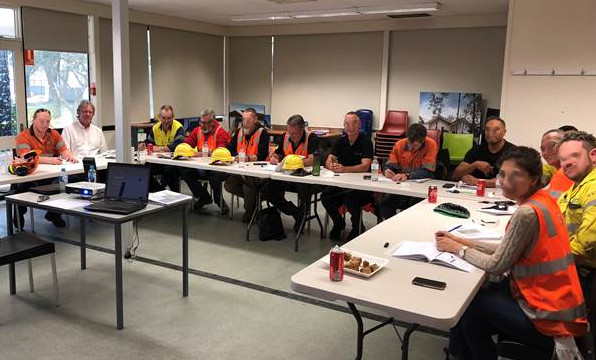WHS for Health and Safety Committees – NSW Edition
PSYCHOSOCIAL RISKS
Introduction
The WHS Act defines ‘health’ as including both physical and psychological health.
A PCBU has a primary duty to ensure, so far as is reasonably practicable, the health and safety of workers and also to ensure that other persons are not put at risk from work carried out arising from the business or undertaking.
When psychosocial hazards and risks at work are not effectively managed, this may increase the risk of work-related psychological and physical injuries, incidents and errors.
Psychosocial hazards at work are aspects of work and situations that may cause a stress response which in turn can lead to psychological or physical harm. These stem from:
- the way the tasks or job are designed, organised, managed and supervised
- tasks or jobs where there are inherent psychosocial hazards and risks
- the equipment, working environment or requirements to undertake duties in physically hazardous environments, and
- social factors at work, workplace relationships and social interactions.
Psychosocial hazards and the appropriate controls will vary for every workplace and sometimes between groups of workers depending on the:
- organisational context to work (e.g. economic pressures, type and size of the business,
- organisational structure and culture, environmental conditions, technologies, and business
- activities, products and services, supply chains and contractual arrangements, workers’ skills and attributes and workplace relationships) and
- content of the work (workload, workers’ roles, responsibilities and activities required to deliver the product or service).
Some hazards by themselves have the potential to cause serious harm, such as experiencing occupational violence. In most circumstances, hazards will not occur alone but together with a range of psychosocial and physical hazards. As part of the risk assessment process the frequency and duration of exposure to psychosocial hazards will need to be considered.
The more psychosocial hazards that are present, the more likely it is for harm to occur. Some of the most common psychosocial hazards are noted below.
There may be hazards not relevant to your work or relevant to your work but not included. These will be identified through your hazard and risk identification processes.

COMMON PSYCHOSOCIAL HAZARDS
| Role overload (high workloads or job demands) | Workplace violence |
| Role underload (low workloads or job demands) | Bullying |
| Exposure to traumatic events | Harassment including sexual harassment |
| Role conflict or lack of role clarity | Inadequate reward or recognition |
| Low job control | Hazardous physical working environments |
| Conflict or poor workplace relationships between workers and their supervisors and managers and co-workers | Remote or isolated work |
| Poor support from supervisors and managers | Poor procedural justice (processes for making decisions) |
| Poor co-worker support | Poor organizational change consultation |
WHAT THE LAW SAYS
The WHS Regulation, sections 55A – 55D:
A person conducting a business or undertaking must manage psychosocial risks in accordance with Part 3.1 other than clause 36. (Hierarchy of Control measures).
Part 3.1 of the Regulation requires a PCBU to manage risks to health and safety.
The WHS Regulation, section 55D:
(1) A person conducting a business or undertaking must implement control measures:
- (a) to eliminate psychosocial risks so far as is reasonably practicable, and
- (b) if it is not reasonably practicable to eliminate psychosocial risks to minimise the risks so far as is reasonably practicable.
(2) In determining the control measures to implement, the person must have regard to all relevant
matters, including:
- (a) the duration, frequency and severity of the exposure of workers and other persons to the psychosocial hazards, and
- (b) how the psychosocial hazards may interact or combine, and
- (c) the design of work, including job demands and tasks, and
- (d) the systems of work, including how work is managed, organised and supported, and
- (e) the design and layout, and environmental conditions,of the workplace,including the provision of:
(i) safe means of entering and exiting the workplace, and
(ii) facilities for the welfare of workers, and - (f) the design and layout, and environmental conditions, of workers’ accommodation, and
- (g) the plant, substances and structures at the workplace, and
- (h) workplace interactions or behaviours, and
- (i) the information, training, instruction and supervision provided to workers.
Safety Committee Involvement
A health and safety committee can assist the PCBU in developing a systematic process to manage psychosocial hazards and risks, which in turn will help the PCBU and duty holders meet their obligations and to reduce incident rates.
It will also decrease organisational disruptions and costs resulting from work-related harm and may improve WHS and broader organisational performance and productivity.

The Hierarchy of Control and Psychosocial Hazards
While a PCBU is not obliged to use Hierarchy of Control measures under clause 55C of the WHS Regulation, a PCBU may use Hierarchy of Control measures if this helps to choose and
communicate the most effective control measures to decision makers and workers in the organisation.
It is important to understand that not being obliged to use Hierarchy of Control only applies with reference to psychosocial risks.
Resources
There are a range of tools and publications available from various regulators to assist duty holders in meeting their obligations including, but not limited to:
SafeWork NSW – Code of Practice – Managing psychosocial hazards at work
SafeWork NSW Guide – Designing Work to Manage Psychosocial Risks
SafeWork Australia – Principles of Good Work Design: a WHS Handbook
www.peopleatwork.gov.au – Psychosocial Risk Assessment Survey Tool
Fair Work Commission – What does “reasonable management action carried out in a reasonable manner” mean?

